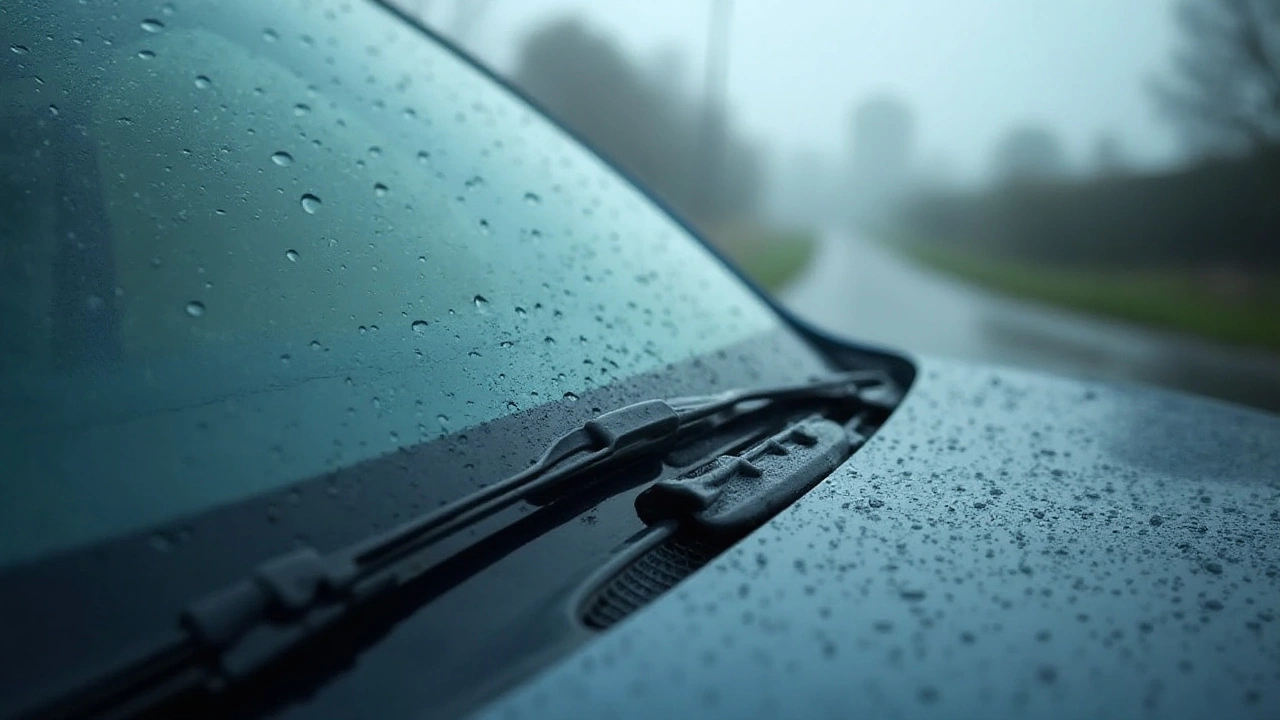When you think about car safety, windshield wipers might not be the first thing that comes to mind. But imagine driving through a heavy rainstorm with inadequate wipers, and you'll quickly realize their importance. Whether you're cruising through Manchester's drizzly streets or tackling a surprise downpour on the motorway, having the right windshield wipers can make all the difference in visibility and safety.
This guide will walk you through the subtle art of selecting the ideal windshield wipers for your vehicle. It's not just about size – the kind of wipers you choose can affect everything from noise levels to the clarity of your view. We'll also provide you with insider tips on keeping those wipers in prime condition, so you'll never be caught staring through smeared glass again.
- Why Choosing the Right Wipers Matters
- Types of Windshield Wipers
- Key Features to Consider
- Maintenance Tips for Longevity
Why Choosing the Right Wipers Matters
When it comes to car maintenance, selecting the right windshield wipers often doesn’t get the spotlight it deserves. Yet, their significance becomes glaringly apparent when caught in a sudden downpour or when dirty sleet from a winter morning begins to blur your view. A streaky windshield can complicate even the shortest drive, risking both your safety and that of others on the road. Picking the right wipers is not just about ensuring a clear view; it's about peace of mind and prosperity behind the wheel.
Good windshield wipers do more than sweep away rain; they also provide an uninterrupted line of sight that is crucial under various weather conditions. According to the National Highway Traffic Safety Administration, nearly 21 percent of all car crashes are weather-related, with poor visibility being a leading contributor. Investing in the right set of wiper blades improves visibility, significantly reducing the risk of accidents.
A variety of wiper blades are available on the market, each serving different needs. The likelihood that a standard blade will be universally effective is slim, given the diverse climates and environments drivers face. Beam blades, for example, provide excellent performance in snow and ice, whereas traditional bracket-style wipers are often better suited to moderate climates. It’s about matching the blade to your specific driving conditions.
“Clear vision isn’t just an aesthetic requirement for driving; it’s a safety imperative,” notes Tom Voelk, an automotive reporter for The New York Times. Such insights shed light on the necessity of considering wipers as more than an interchangeable car part.Understanding your driving habits and the weather patterns in your area can influence your choice. Manchester's frequent rain, for instance, may demand high-quality rubber wipers capable of handling persistent moisture efficiently, without leaving annoying streaks that compromise sight.
Another often-overlooked factor is the longevity of the wipers. While it might be tempting to go for the least expensive option, investing in a quality product can save money over time, minimizing the need for frequent replacements. Premium brands use materials designed to withstand wear and tear better, providing consistent performance even after months of use. Climate variations can significantly impact the effectiveness and lifespan of your blades, making the right choice an economically wise long-term investment.
Choosing the right wipers also involves considering your vehicle's specific build and requirements. Some cars are equipped with windshield washers and sensors that prioritize specialized blades. Performance can drastically suffer if you select a universal blade that doesn't meet your car’s exact specifications. Therefore, a careful selection process involving research, perhaps discussing options with a trusted auto parts specialist, can ensure that you opt for the blade that best suits your needs. Ultimately, the time and thought put into choosing your windshield wipers can yield dividends in safety, cost savings, and driving comfort.

Types of Windshield Wipers
When it comes to windshield wipers, not all are created equal. The market offers a variety of options, each designed to meet different needs and preferences. Understanding these types is crucial for anyone looking to maximize their driving safety and comfort. Traditional frame-style wipers have been around for decades and are still widely used. They feature a metal framework that supports multiple contact points along the length of the blade. This design allows them to conform to curved windshields, providing reliable cleaning performance across the board. However, they can accumulate snow and ice, which might affect their performance in harsh winter conditions.
In recent years, beam-style wipers have gained popularity due to their sleek design and enhanced performance. Unlike frame-style blades, beam wipers are constructed from a single piece of rubber, eliminating the external frame. This design helps to reduce drag and noise while ensuring constant contact with the windshield, thus promoting superior wiping action in varied weather conditions. Beam wipers often come with natural rubber coated with graphite, ensuring long-lasting durability and quiet operation. They are an excellent choice for those who frequently encounter heavy rain or snow.
Hybrid Windshield Wipers
Then there are hybrid wipers, which aim to provide the best of both worlds. These wipers combine the stable performance of framed wipers with the improved aerodynamics of beam wipers. They usually feature a conventional frame for strength and a sleek, rubber shell to prevent icing and improve windshield contact. This hybrid approach makes them versatile and often a preferred choice for drivers who experience varied climates. Moreover, some wipers now incorporate advanced technologies. Examples include blades with heated elements to melt away ice and snow or wipers integrated with advanced water-repellent coatings like silicone rubber, which encourages rain to bead off the glass more effectively."The advances in windshield wiper technology might seem minute, but they can greatly enhance driving safety," says Mark Frost, an automotive safety analyst.Choosing between these types of wipers depends on several factors, including climate, driving habits, and budget. While frame and hybrid wipers are more cost-effective, beam wipers may offer better long-term performance and satisfaction. Consider the conditions you'll drive in most to determine which type suits you best.

Key Features to Consider
Choosing the right windshield wipers can seem daunting with so many options out there, but understanding key features can simplify your decision. The blade material is top of the list; most wipers are made from rubber, though a premium selection uses silicone. Silicone blades might cost more initially, but they last longer and render a smoother, quieter wipe. Wiper blades made from silicone often offer better performance in extreme temperatures, be they sweltering or freezing, which is perfect for those unpredictable UK weather shifts.
Size compatibility is another crucial aspect. While it might appear obvious, many people overlook checking the correct size for their vehicle model, leading to poor performance or even damage. It's not rare to see mismatched pairs, where drivers assume ‘one size fits all.’ Always refer to your car manual or manufacturer’s website to know the correct measurements. According to an article in Auto Express, "A snug fit is essential as a correctly sized blade ensures uniform pressure across the screen, avoiding those pesky smudge spots or streaks."
Another feature to consider is the type of wiper arm connector. There’s the common hook slot, but you may encounter pin type or bayonet fittings. Checking your existing wipers or your vehicle manual can save you from a frustrating trip back to the store. Some newer blade models are designed to be compatible with multiple fittings, a handy innovation for sure.
Let’s not forget about weather-specific wipers. For those in wintry locales, winter wipers are encased in a robust rubber shell to prevent ice buildup, leading to a longer lifespan. However, if you're navigating urban areas frequently, hybrid blades might be ideal. They combine the best features of traditional frame blades with the aerodynamics of beam blades, ensuring a sturdier, more secure performance even at high speeds.
Noise level is also a factor, particularly for those who spend a lot of time on the road. Certain wiper blades, like the beam-type, produce less noise during operations, as they apply even pressure throughout their surface. This can genuinely enhance your driving experience during those long motorway journeys. Finally, don't neglect brand reputation. While no-name brands can be tempting due to their low cost, well-established manufacturers often offer better durability and efficiency. Checking out reviews or asking a trusted local mechanic can provide peace of mind.
Consider your driving environment, too. Frequent exposure to rain might require the investment in high-end models, while infrequent use could mean standard blades suffice. Investing time in understanding these features will undoubtedly help you select the optimal auto parts for your vehicle, ensuring crystal-clear visibility in all manner of conditions.

Maintenance Tips for Longevity
Maintaining your windshield wipers is crucial to ensure they perform effectively when you need them most. These unsung heroes of clear vision often go unnoticed until a heavy storm or snowfall hits, yet they deserve regular attention. One key aspect of maintenance is checking their condition periodically. It's a simple step that can save you a world of trouble down the line. Look for signs of wear, such as cracks or splits in the rubber, which can lead to streaking or reduced wiping performance.
An effective way to promote longevity is by cleaning your wiper blades regularly. Dirt, sand, and grime can all accumulate on the blades, degrading their performance. Use a damp cloth soaked in mild soap and water to gently wipe away any debris, followed by a rinse with clean water. A well-maintained blade ensures smooth operation and maximum contact with your windshield, providing you with a streak-free view even during the heaviest of showers.
It's not just the blades that need attention – keep an eye on your wiper arms too. These vital components can get bent or damaged, affecting the pressure they apply to the windshield. Run your fingers along the edges of the windshield and the path of the blades to ensure everything is aligned and free from obstacles. Every few months, lift the wiper arms off the windshield and let them snap back gently to check for proper tension.
"A properly maintained wiper blade can sweep away the dangers of a blurred vision like a knight warding off a storm," remarks automotive expert John Hargrove, whose insights have been featured on several prominent car maintenance forums.
Seasonal changes can also impact your wipers' lifespan. In colder climates, make a habit of lifting the blades off the glass when parked overnight to prevent them from freezing onto the windshield. For hot and sunny environments, try to park in the shade to avoid excessive heat exposure, which can dry out and crack the rubber. Using a windshield cover during extreme weather is an excellent strategy to protect your wipers from the elements.
Finally, don't ignore the warning signs of failing wiper blades. Squeaking sounds can indicate they’re dry, overly loose, or worn out. On the other hand, if they leave streaks, it's time for a replacement. Many manufacturers recommend changing your wiper blades every six to twelve months, depending on the climate you live in and the amount of use they get. Following these tips will keep your windshield wipers in optimal condition, ensuring you can drive safely through whatever Mother Nature throws your way.

